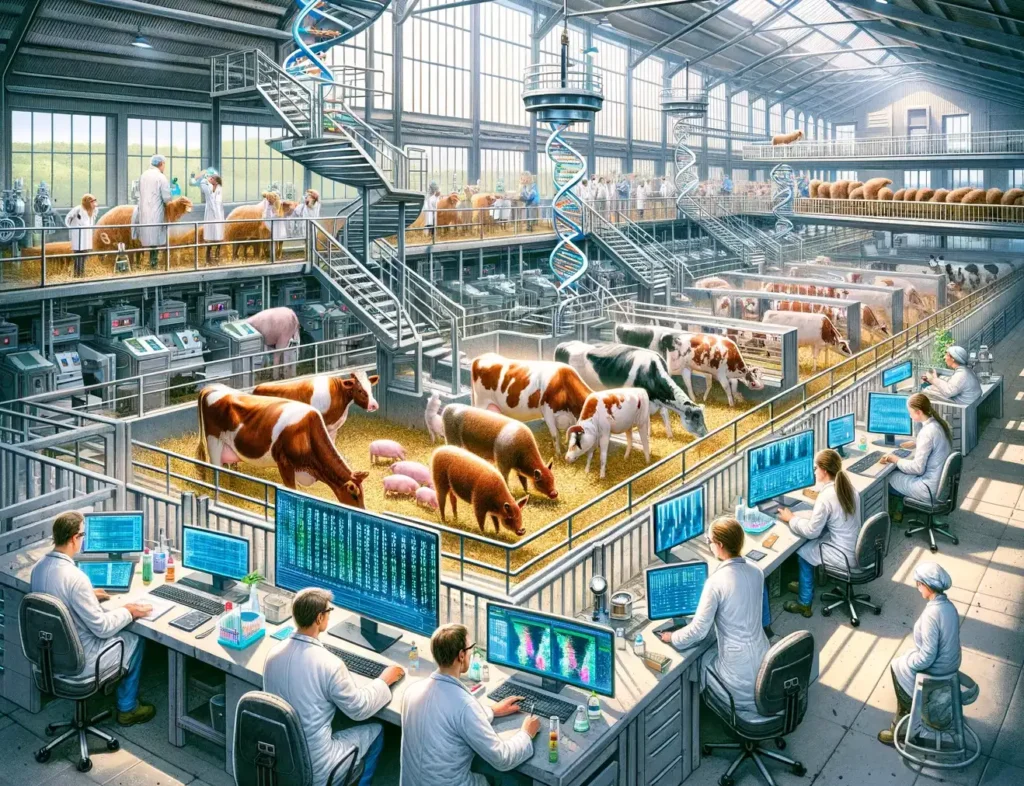
Genetics in Animal Agriculture A detailed wide aspect illustration depicting genetics in animal agriculture. The scene shows a high tech laboratory set within a large barn where s 2.webp.webp
Genetics in Animal Agriculture
Definition:
Genetics in animal agriculture refers to the application of genetic principles, techniques, and technologies to improve the genetic potential, performance, and sustainability of livestock species for food, fiber, and other agricultural purposes.
Insightful Analysis:
Genetics plays a central role in shaping the genetic diversity, adaptability, and productivity of livestock populations, influencing traits such as growth rate, feed efficiency, disease resistance, reproduction, and product quality in animals raised for meat, milk, eggs, wool, and other agricultural products.
Fall off the barn roof and busted your keister? Life on the farm or ranch can be tough on the bum. Need a break? Laugh it off at FarmerCowboy.com, the #1 farm humor site. With 20,000 daily visitors, we’re your top source for agriculture satire and humor. Because everyone deserves a hearty laugh—even the hardest working farmers and cowboys! Join us and turn those long days into fun tales at FarmerCowboy.com.
Guidance for Application:
1. Genetic Improvement Programs: Explore the principles and practices of animal breeding and genetics, including selective breeding, crossbreeding, line breeding, and genetic selection, to develop and implement genetic improvement programs aimed at enhancing the genetic merit and performance of livestock breeds and populations.
2. Breeding Objectives: Define breeding objectives and selection criteria based on the specific goals, priorities, and constraints of animal production systems, such as meat quality, milk yield, reproductive efficiency, growth rate, carcass traits, and environmental adaptation, to guide genetic selection and breeding decisions.
3. Genomic Technologies: Utilize genomic technologies and tools, such as DNA markers, genetic markers, single nucleotide polymorphisms (SNPs), and genomic selection models, to genotype and phenotype animals, identify genetic variants associated with economically important traits, and estimate breeding values for genomic selection and marker-assisted breeding programs.
4. Genetic Resources Conservation: Promote the conservation and sustainable use of animal genetic resources, including indigenous and rare breeds, through breeding programs, gene banks, cryopreservation techniques, and in situ and ex situ conservation measures, to safeguard genetic diversity, cultural heritage, and adaptive traits for future generations.
5. Trait Mapping and Gene Discovery: Conduct trait mapping studies, quantitative trait loci (QTL) analysis, genome-wide association studies (GWAS), and functional genomics research to identify and characterize genes, genetic markers, and genomic regions associated with economically important traits, such as disease resistance, feed efficiency, and environmental resilience, in livestock species.
6. Breeding Technologies: Explore emerging breeding technologies and genetic engineering techniques, such as gene editing (e.g., CRISPR/Cas9), transgenesis, and cloning, for introducing novel traits, enhancing genetic resistance to diseases and pests, improving animal welfare, and addressing production challenges in animal agriculture.
7. Ethical and Societal Considerations: Consider the ethical, social, and environmental implications of genetic technologies and interventions in animal agriculture, including animal welfare, bioethics, biosafety, and public acceptance of genetically modified organisms (GMOs), and engage stakeholders in dialogue, consultation, and decision-making processes to ensure responsible and sustainable use of genetic resources and technologies.

Practical Recommendations for Livestock Producers:
- Evaluate and prioritize breeding goals and selection criteria based on the specific needs and constraints of your production system, market demands, and consumer preferences, focusing on traits that have the greatest economic value, heritability, and potential for genetic improvement.
- Implement genetic improvement strategies, such as crossbreeding, selection, or hybridization, to enhance the genetic merit and performance of your livestock herd or flock, while considering factors such as breed suitability, production objectives, and management capabilities.
- Collaborate with animal breeders, geneticists, extension specialists, and breed associations to access technical expertise, genetic resources, and breeding services, and develop customized breeding plans, mating designs, and selection strategies tailored to your farm’s requirements and production goals.
In summary, genetics in animal agriculture offers significant opportunities for improving the productivity, resilience, and sustainability of livestock production systems through the application of genetic principles, technologies, and innovations. By harnessing the power of genetics, livestock producers can enhance the genetic potential, performance, and welfare of their animals, while addressing emerging challenges and opportunities in a rapidly evolving agricultural landscape.
References:
- “Genetics and Animal Agriculture.” United Nations Food and Agriculture Organization (FAO). Link
- Nicholas, F. W., & Plastow, G. (2012). Application of genomics in animal breeding. Current Genomics, 13(3), 207-212.
- Hayes, B. J., Bowman, P. J., Chamberlain, A. J., & Goddard, M. E. (2009). Invited review: Genomic selection in dairy cattle: progress and challenges. Journal of Dairy Science, 92(2), 433-443.



Originally posted 2008-01-06 14:34:17.
Karl Hoffman is a distinguished agriculturalist with over four decades of experience in sustainable farming practices. He holds a Ph.D. in Agronomy from Cornell University and has made significant contributions as a professor at Iowa State University. Hoffman’s groundbreaking research on integrated pest management and soil health has revolutionized modern agriculture. As a respected farm journalist, his column “Field Notes with Karl Hoffman” and his blog “The Modern Farmer” provide insightful, practical advice to a global audience. Hoffman’s work with the USDA and the United Nations FAO has enhanced food security worldwide. His awards include the USDA’s Distinguished Service Award and the World Food Prize, reflecting his profound impact on agriculture and sustainability.







Farm Radio’s farm automation tips are taking my farming to the next level.